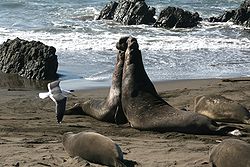This is an old revision of this page, as edited by 92.43.64.70 (talk) at 09:58, 3 October 2008 (→Ecology). The present address (URL) is a permanent link to this revision, which may differ significantly from the current revision.
Revision as of 09:58, 3 October 2008 by 92.43.64.70 (talk) (→Ecology)(diff) ← Previous revision | Latest revision (diff) | Newer revision → (diff)
| Elephant Seal | |
|---|---|

| |
| Male and female Northern Elephant Seals | |
| Scientific classification | |
| Kingdom: | Animalia |
| Phylum: | Chordata |
| Class: | Mammalia |
| Order: | Carnivora |
| Suborder: | Pinnipedia |
| Family: | Phocidae |
| Genus: | Mirounga |
| Species | |
Elephant seals are large, oceangoing mammals in the genus Mirounga, in the earless seal (Phocidae) family. There are 2 species: the Northern Elephant Seal (M. angustirostris) and the Southern Elephant Seal (M. leonina). Both were hunted to the brink of extinction by the end of the nineteenth century, but numbers have since recovered. The Northern Elephant Seal, somewhat smaller than its southern relative, ranges over the Pacific coast of the U.S., Canada and Mexico. The Southern Elephant Seal is found in the southern hemisphere on islands such as South Georgia, Macquarie Island, and on the coasts of New Zealand, South Africa, and Argentina in the Peninsula Valdés, which is the fourth largest elephant seal colony in the world.
Appearance

Elephant seals take their name from the large proboscis of the adult males (bulls) which resembles an elephant's trunk. The bull's proboscis is used in producing extraordinarily loud roaring noises, especially during the mating season. More importantly, however, the nose acts as a sort of rebreather, filled with cavities designed to reabsorb moisture from the animals' exhalations. This is important during the mating season when the male seals rarely leave the beach to feed, and therefore must conserve body moisture, as they have no incoming source of water. Bulls of both the northern elephant seal and the southern elephant seal reach a length of 16 ft (5 m) and a weight of 6,000 lb (3,000 kg), and are much larger than the cows, which typically measure about 10 ft (3 m) and 2,000 lb (900 kg). The largest known bull elephant seal weighed 5000 kg (11,000 lb) and measured 6.9 m (22.5 ft) in length. This makes the elephant seal the largest member of the order Carnivora.
Ecology

Elephant seals spend up to 80 percent of their lives in the ocean. They can hold their breath for over 80 minutes—longer than any other non-cetacean mammal. Furthermore, elephant seals possess the ability to dive to 2000 meters beneath the ocean's surface (the deepest recorded dive of an Elephant Seal is 1,581m by a male in 1989). The average depth of their dives is about 300 to 600 meters, typically for around 20 min for females and 60 min (1 hour) for males, as they search for their favorite foods, which are skates, rays, squid, octopuses, eels, and small sharks. Their stomachs also often contain gastroliths. While excellent swimmers, they are even more surprising on land, where they have a higher velocity than the average human when moving over sand dunes.
Elephant seals are shielded from extreme cold by their blubber, more so than by fur. The animals' hair and outer layers of skin molt periodically. The skin has to be re-grown by blood vessels reaching through the blubber. When molting occurs, the seal is susceptible to the cold, and must rest on land, in a safe place called a "haul-out." While the molt is taking place the bulls cease fighting with one another because of the danger posed to their unprotected hides.
Elephant seals have evolved to have a very large volume of blood, allowing them to hold a large amount of oxygen for use when diving. They have large sinuses in their abdomens to hold blood and can also store oxygenated blood in their muscles. In addition they have a larger proportion of oxygen-carrying red blood cells. All these adaptions enable them to dive for periods up to 2 hours. HIIIIIIIIIIIIIIIIIIIIIIIIIidfhwfhehfefefefgefgyegfyegfyeyfgeyfgyefyeg
Lifespan
Female elephant seals have an average life expectancy of about 23 years, and can give birth starting at the age of 3–4. Males reach maturity at five years, but generally don't achieve alpha status until the age of 8, with the prime breeding years being between ages 9 and 12. The average life expectancy of a male elephant seal is 20 years.
Gallery
-
 Elephant seals (Mirounga angustirostris) on a beach, San Simeon, California
Elephant seals (Mirounga angustirostris) on a beach, San Simeon, California
-

-
 Northern Elephant Seals during moulting season near San Simeon, California, USA
Northern Elephant Seals during moulting season near San Simeon, California, USA
See also
References
- Elephant Seal, Elephant Seal Profile, Facts, Information, Photos, Pictures, Sounds, Habitats, Reports, News - National Geographic
- Elephant Seals
- Elephant Seal - MSN Encarta
- BBC NEWS | Science/Nature | Elephant seals dive for science
- http://www.alaskasealife.org/master/animal_fact/factsheet_elephantseal.pdf
- Australian Antarctic Division - Southern seals: aquatic performers
- Elephant seal facts: New Zealand marine mammals